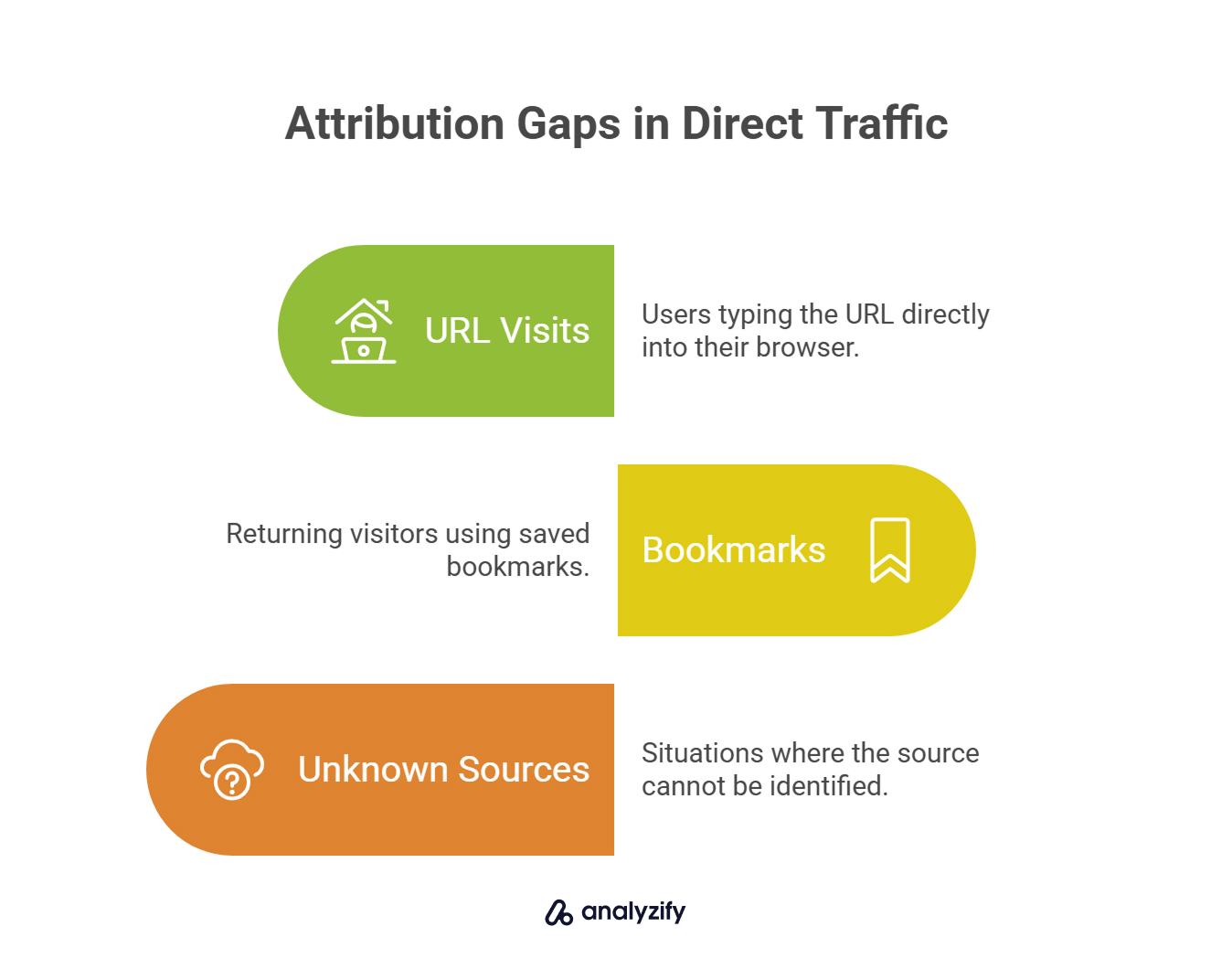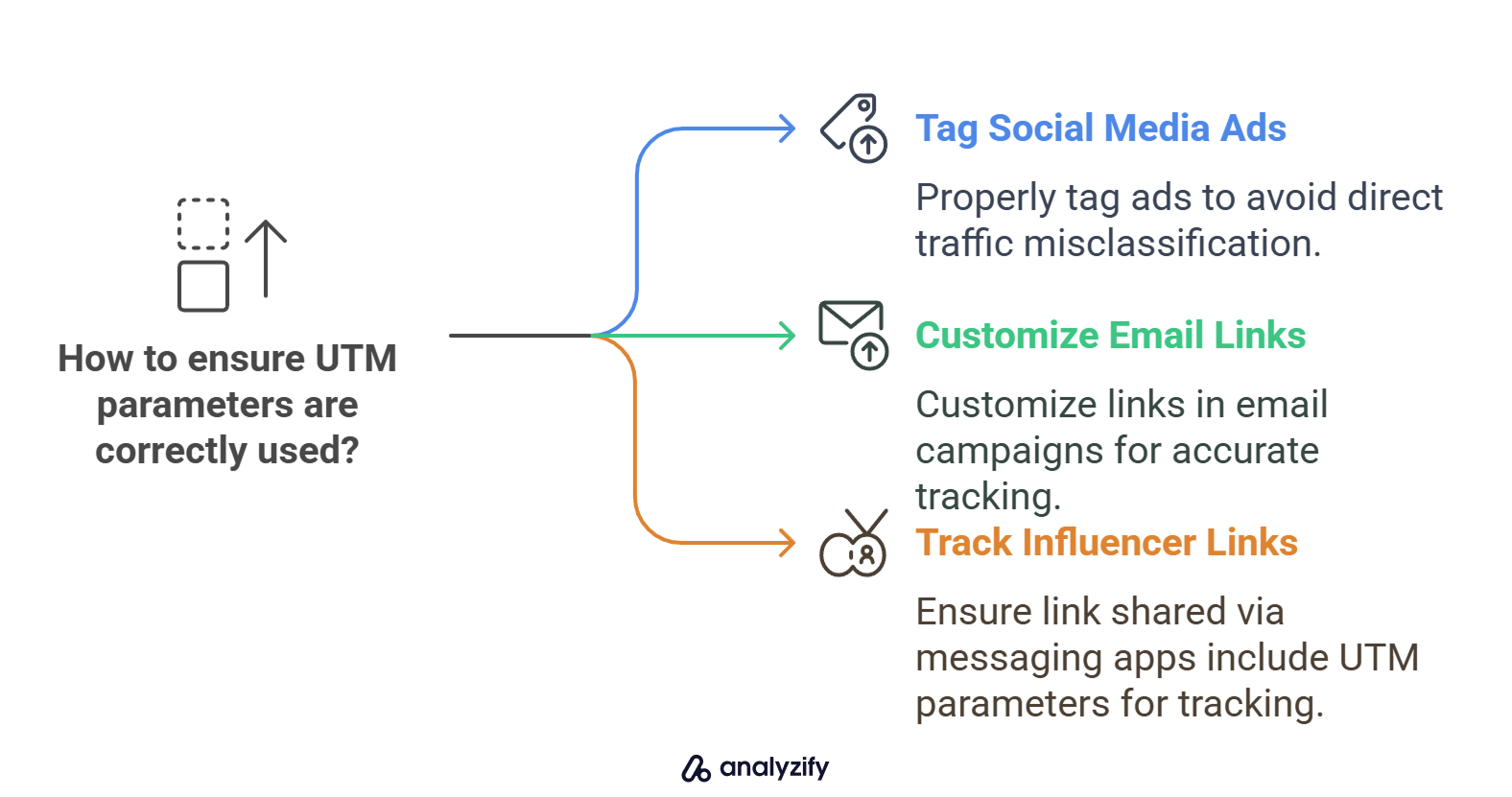If you’re staring at a big chunk of traffic in Google Analytics 4 labeled as “direct” and thinking, “That can’t be right,”—you’re not alone. It’s one of the most common points of confusion we hear from merchants.
What makes it worse? You know your traffic came from somewhere—an ad, an email, a social post—but the data doesn’t show it. Instead, it lands in the black hole of “direct,” and you’re left guessing what actually drove that sale.
In this guide, we’ll break down what’s really behind direct traffic, why it often shows up inaccurately in GA4, and how Analyzify’s server-side tracking can fix it—so you can stop making decisions in the dark.
1) What Is Direct Traffic in Google Analytics (GA4), Really?
Google Analytics 4 defines “direct” traffic as visits where the source can’t be identified. That includes:
- Users typing your URL directly into their browser
- Returning visitors using bookmarks
- Any situation where GA4 can’t figure out where the visit came from

In other words, direct traffic is often just unknown traffic.
This wouldn’t be a problem if it only included true direct visits. But in reality, it often captures traffic that was originally from ads, emails, or social links—just without the proper tracking data attached. That’s where the confusion begins, and where most attribution gaps start to show.
2) Why “Direct” Isn’t Always Direct: Common Causes of Misattribution
Direct traffic isn’t always what it claims to be. In fact, when we see unusually high direct traffic in GA4, it usually means something’s broken in the tracking setup.
Here are the most common culprits:
1. UTM Parameters Are Missing or Incomplete
If your marketing links—especially in emails, paid ads, or social posts—don’t include UTM parameters, GA4 can’t recognize the source. The result? That click shows up as direct.

his is especially common with:
- Facebook and Instagram ads that use destination URLs without proper UTM tagging
- Email newsletters or flows (e.g., Klaviyo) where links haven’t been customized
- Links shared via messaging apps or influencers without any tracking parameters
2. Cross-Domain Tracking Isn’t Set Up Properly
If your store uses more than one domain (e.g., a branded domain and a checkout domain like myshopify.com), and GA4 isn’t told how to stitch them together, sessions can break mid-journey.
GA4 will treat that as a new session without a source—resulting in direct traffic.
![]()
3. Redirects Are Stripping Tracking Info
Some merchants unknowingly run campaigns with URLs that redirect (e.g., from www to non-www, or.app to.com). During that redirect, the UTM parameters can get dropped—along with the source data.
If a click lands on your final URL without its original parameters, GA4 sees it as direct.
![]()
4. Tracking Code Is Missing from Some Pages
This one’s simple but often overlooked: if your GA4 tag (or GTM container) isn’t installed on every page, especially custom landing pages, GA4 can’t track the full session. You may see visits start mid-funnel with no source attached—again, marked as direct.
![]()
5. Multiple Analytics Tags Causing Conflicts
Duplicate tags or misconfigured GA4 properties can lead to unpredictable behavior. Sometimes one tag fires, and another doesn’t. Sometimes both do, but one overrides the other. Either way, the original source can be lost.
Taken together, these issues create a funnel full of blind spots. But the good news is that most of them are solvable—and in the next section, we’ll show you how server-side tracking closes the loop.
3) Can Server-Side Tracking Fix Your Direct Traffic Problem?
Analyzify’s server-side tracking for GA4 is engineered to improve your purchase-level attribution accuracy by up to 98%, storing first-party data directly in your Shopify store.
It helps eliminate tracking gaps where browser-based tracking fails—particularly when it comes to recording the source of orders. Therefore, if you’re seeing high volumes of misattributed direct traffic in your purchase data, Analyzify’s server-side tracking can be the most effective way to fix it.
That said, not all direct traffic issues are order-related. Problems in session-level attribution—like inflated session counts, lost referral data in GA4 reports, or incorrect traffic sources—are addressed by Analyzify’s core product, which includes advanced UTM tracking, GA4 enhancements, and GTM-based attribution improvements.

In short:
- Analyzify core improves session-level attribution and analytics accuracy
- Analyzify Server-side tracking secures purchase-level attribution when browser tracking fails
Analyzify’s server-side solution accurately records which marketing channel or campaign brought the customer to your store and connects that data to the eventual order. This data flows directly from Shopify through Analyzify’s secure servers to GA4, providing more reliable attribution data than client-side tracking.
Let’s take a closer look at both the technical fix and the real business impact.
It Captures and Stores Attribution at the Source
Analyzify logs the original referral or campaign data at the first touchpoint and stores it within your Shopify backend—specifically for purchase-level attribution. This means the campaign or source data is tied to the order itself, not to the session. Even if the session splits across domains or devices, the original source still flows through to your analytics tools.
When a purchase happens, Analyzify sends this order-level attribution data directly to GA4 or Meta via secure APIs.
4) GA4 Server-Side Tracking: Built for Shopify Merchants
Analyzify’s server-side tracking is built specifically for Shopify, leveraging the platform’s latest technology to ensure optimal performance.
![]()
You get complete checkout tracking across all steps of the purchase process, while maintaining seamless integration with your existing store setup without affecting site speed or performance:
- 10-minute easy setup
- 98% tracking accuracy
- Reliable conversion tracking
- First party attribution data
- Ad blocker resistant tracking
- No custom development required
![]()
5) Why Attribution Data in GA4 Matters
When a significant portion of your traffic is labeled “direct,” you lose visibility into what’s actually driving your sales. It may not seem urgent at first—but over time, it affects nearly every aspect of your marketing and business decisions.
Here’s what’s really at stake:
You Undervalue the Channels That Are Working
Let’s say a Facebook ad brings someone to your store, but due to broken attribution, that visit shows up as “direct.” You run your performance report and conclude that Meta isn’t converting well—so you reduce spend or shut it off completely.
This happens quietly, but consistently. When the data doesn’t show what worked, high-performing channels get less credit than they deserve—and your growth slows down without a clear reason.
Analyzify fixes this by correctly attributing orders back to Meta, Google Ads, Klaviyo, and more.
Your Core Metrics Become Misleading
Metrics like ROAS and CAC rely on knowing where your traffic and conversions come from. If GA4 attributes 30% of your orders to “direct” with no context, your calculations are off.
That makes it nearly impossible to:
- Compare performance across channels
- Forecast revenue accurately
- Allocate budget confidently
With Analyzify in place, the data behind those metrics becomes accurate and actionable.
Your Customer Journey Becomes Invisible
Marketing isn’t linear. Customers might click a Google ad, see a retargeting campaign on Instagram, then finally buy after receiving an email. If any one of those touchpoints gets lost, the story breaks down.
When sessions are misattributed to “direct,” you can’t:
- Identify what sparked the first visit
- Understand which channels assist conversions
- See how long or complex your sales cycle really is
Analyzify ensures each of those steps is recorded accurately—even across domains and devices.
You Miss the Confidence to Scale
When the data doesn’t reflect reality, your confidence drops. You don’t know what to scale, what to test, or what to stop. You second-guess results, and planning future campaigns becomes more stressful than strategic.
Fixing attribution isn’t just about cleaner reports—it’s about giving yourself the clarity to grow.
And that’s exactly what Analyzify’s server-side tracking makes possible.
6) What You Can Do Today to Reduce Direct Traffic Misattribution
Even if you haven’t switched to server-side tracking yet, there are several steps you can take right now to reduce inaccurate “direct” traffic in GA4.
This is about tightening up your current setup—eliminating weak points that cause source data to disappear.
Bonus: Learn more about The Reasons and Solutions for Direct Traffic Problem in GA4!
✅ Use UTM Parameters Consistently
UTMs are your first line of defense. Every link you share in an email, ad, or social post should include:
- utm_source
- utm_medium
- utm_campaign
Tools like Klaviyo, Meta Ads Manager, and Google Ads allow dynamic UTMs—use them. And if you’re sharing links manually, double-check that parameters are included.
✅ Audit Your GA4 & GTM Setup
Make sure your GA4 tag (or GTM container) is installed once—and only once—on every page of your site, including:
- Custom landing pages
- Blog posts
- Password pages
- Cart and checkout (when applicable)
Multiple or missing tags can break sessions and erase referral data.
✅ Fix Cross-Domain Tracking
If your store moves between domains (e.g. yourstore.com to checkout.shopify.com), set up cross-domain tracking in GA4. Otherwise, the source data will reset mid-session and show up as “direct.”
You can do this in GA4’s “Configure your domains” settings under Data Streams.
✅ Avoid Redirects That Strip UTM Parameters
Make sure you’re not sending users through unnecessary redirects, especially if those redirects lead to a different domain or drop query parameters. Even a www to non-www redirect can cause problems if misconfigured.
✅ Double-Check Your Email and SMS Platforms
Some email tools (like Klaviyo or Omnisend) don’t automatically include UTMs unless you set them up. Also, email privacy features (like Apple Mail) may strip referral data—making server-side tracking even more important in the long run.
These steps can significantly reduce misattribution.
But if you want reliable tracking across all platforms—and attribution that holds up across devices, sessions, and browsers—server-side is the most complete solution.
Final Thoughts: Stop Guessing, Start Seeing the Full Picture
If you’re seeing too much direct traffic in GA4, it’s not just an analytics quirk—it’s a sign that your attribution setup isn’t capturing the full story. And when source data goes missing, every decision you make is built on incomplete information.
The good news? You don’t have to settle for that.
Analyzify’s server-side tracking is built specifically to solve this problem for Shopify merchants. It captures the real source of your orders—even when traditional tracking breaks down—so you can finally trust what your data is telling you.
Whether you’re running Meta ads, email flows, or influencer campaigns, you’ll know exactly where your sales are coming from. And once that clarity is in place, your marketing becomes easier to optimize, scale, and justify.
![]()

































